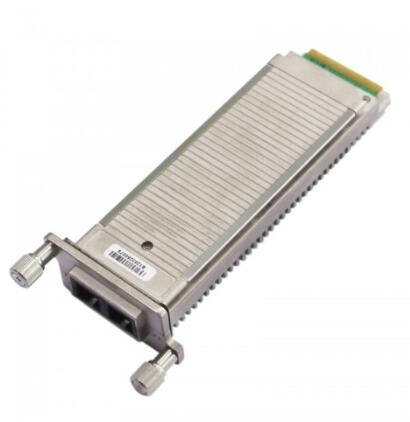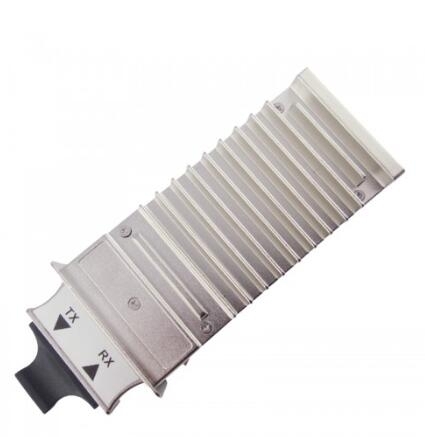- Related articles
- Optical Transceivers for Cisco SF200-24FP-UK Switch
- What is motherboard network card?
- Optical Transceivers for Cisco SLM248GT-UK Switch
- All Cisco MA-SFP-1GB-LX10's information (List price, Specs, Datasheet PDF, Compatibility m
- Optical Transceivers for Cisco SG250-26P-K9-EU Switch
- What is a server adapter?
- Basic Information of Intel Ethernet Card
- What are SFP slots?
- All Cisco ONS-XC-10G-L2's information (List price, Specs, Datasheet PDF, Compatibility mat
- All Cisco ONS-SI-622-L2's information (List price, Specs, Datasheet PDF, Compatibility mat

Definition:
XENPAK is a multisource agreement (MSA), instigated by Agilent Technologies and Agere Systems, that defines a fiber-optic or wired transceiver module which conforms to the 10 Gigabit Ethernet (10GbE) standard of the Institute of Electrical and Electronics Engineers (IEEE) 802.3 working group. The MSA group received input from both transceiver and equipment manufacturers during the definition process. XENPAK has been replaced by more compact devices providing the same functionality.

X2 optics is essentially an enhanced version of the Xenpak. It also has the same connector as a Xenpak (SC). Cisco introduced the X2 form factor and HP is producing them as well. Although X2 optics is quite old and bulky, they are still used in the newer product line of Cisco, i.e. the ASR 9000 series. The reason for this is that Cisco has not officially offered the SFP+ for longer distances or a SFP+ for DWDM. The X2 optics come in 4 different versions: SX, LX, EX and ZX. The SX version will work on Multi Mode fiber, the LX, EX and ZX work only on Single Mode fiber.

XENPAK vs X2
| Package | Data Rate/ Application | Wavelength | Distance | Interface | Fiber Mode | Fiber Count |
| X2 | 10G Ethernet/SDH/SONET/Fiber Channel | DWDM 850nm 1310nm 1550nm CWDM 1270nm~1450nm CWDM 1470nm~1610nm | 220m 300m 10km 40km 80km | SC | Single-Mode Multi-Mode | Dual Fiber |
| XENPAK | 10G Ethernet/SDH/SONET/Fiber Channel | DWDM 850nm 1310nm 1550nm CWDM 1470nm~1610nm | 220m 300m 10km 40km 80km | SC | Single-Mode Multi-Mode | Dual Fiber |
Difference Between X2-10GB-SR and XENPAK-10GB-SR:
10GBASE X2 modules offer customers a wide variety of 10 Gigabit Ethernet connectivity options for data center, enterprise wiring closet, and service provider transport applications.
Main features of Cisco 10GBASE X2 modules include:
- Support 10GBASE Ethernet
- Hot-swappable input/output device plugs into an Ethernet X2 port of a Cisco switch or router to link the port with the network
- Provides flexibility of interface choice
- Supports “pay-as-you-populate” model
- Has optical interoperability with respective 10GBASE Xenpak, 10GBASE XFP and 10GBASE SFP+ modules on the same link
10GBASE XENPAK modules offers a wide variety of 10 Gigabit Ethernet connectivity options for data center, enterprise wiring closet, and service provider transport applications.
Main features of Cisco 10GBASE XENPAK modules include:
- Supports 10GBASE Ethernet
- Hot-swappable input/output device plugs into an Ethernet XENPAK port of a Cisco switch or router to link the port with the network
- Provides flexibility of interface choice
- Supports “pay-as-you-populate” model
- Interoperable with respective Cisco 10-Gigabit X2, XFP and SFP+ modules on the same link.
Can we interconnect SFP-10G-SR to XENPAK-10GB-SR or X2-10GB-SR?
The answer is yes. For this problem, you just need the correct optic on each side. If your optics are singlemode you need singlemode patch cord. If your optics are multi-mode then you need multi-mode patch cord. SFP-10G-SR, XENPAK-10GB-SR and X2-10GB-SR are all multi-mode optics, so a multi-mode fiber can solve this problem.
Conclusion:
X2 is an upgraded version of xenpak. XENPAK is a highly integrated, serial optical transponder module for high-speed, 10Gbit/s data transmission applications. It is designed to transmit and receive optical data of link length of 300M, 10km, 20km, 40km, up to 80km. XENPAK 10GB solution include dual fiber XENPAK, CWDM XENPAK and DWDM XENPAK modules which enable high port densities for 10 GbE systems. A 70 pin electrical connector and a duplex SC connector optical interface assure that connectivity is compliant to the XENPAK MSARev.3.0.
X2 Optics are a standardized form factor for 10 Gbps fiber optics transponders. Both 10G Ethernet and 10G Fibre Channel versions are available. X2 optics are used in datacom optical links only (not telecom), and they are smaller than XENPAK transponders.





















































